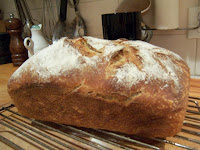 |
Above: A delicious simple wheat loaf, baked in my ordinary gas oven.
|
Sourdough is a fun process, but it can be time consuming for the beginner. If you are familiar with sourdough and have made your own starter, these shortcuts should help.
These shortcuts help you make a loaf - super fast! The only slow part is resting it in the fridge overnight, but this is necessary - or the yeasties won't predigest the 'bad' parts of the flour properly and you'll feel very bloaty.
If you don't have a starter yet, relax - check out my 2007 blog "Lets Bake Bread" #1 to learn how to make your own little community.
Here I have distilled down the basics so you can get a loaf happening:
Here I have distilled down the basics so you can get a loaf happening:
1. Have your own starter. YOu can cultivate it in your own kitchen from flour, water and air. See 2007 "Let's Bake Bread #1" to see how to make your starter.
2. Follow the instructions in the January 2008 Blog - Honey corn bread. Or read here:
Put your starter in a bowl with lukewarm, filtered water and organic plain flour. Equal parts - 2 cups water, 2 cups flour. Stir and cover with a tea towel overnight. In the morning it should be bubbling beneath the surface. If not - wait another hour or two.
 | ||||
| I love to bake my loaves to a rich, deep brown. Funny thing about sourdough is that it is very hard to burn, and even a deep brown loaf tastes beautiful. |
3. When bubbled, put some sponge in the fridge in a jar to make a new starter for next time (a few tablespoons, with a teaspoon of flour for it to 'feed' off when in hibernation). Take the rest of the sponge and add enough plain organic flour to it to make a very sticky dough that just holds together.
4. Let it rise for around 1-2 hours, depending on the strength of your starter - you know your own critters the best.
5. Gently 'pound down' the risen dough and leave in fridge overnight. I like to put the dough in a plastic bag with a peg to stop the dough over-expanding and 'eating itself' too much.
6. Take it out of the fridge in the morning and lay it on a nice stone pizza slab, a cast iron pot or a bread tin. Different baking methods give different crustiness and taste.
 |
Bake in a pot, on a slab or in a tin
7. Leave dough in a warm place for its second rising - 1 to 2 hours. Before baking, slash a criss-cross or other pattern with a knife. This isn't just for looks - it helps the bread rise more.
8. For an extra 'rise', don't preheat the oven - throw the bread in 'cold' and turn the oven on to 200 degrees. As the oven heats up the bread gets and extra rise. Cook until quite brown and 'hollow' to the tap.
This is a quick bread with a great texture - should be chewy and 'holey':
 |
| When made with less flour (a more 'wet' dough) and almost no kneading, your bread will have the holey, chewy, delicious traditional sourdough taste and texture |



Hi, very interesting post, greetings from Greece!
ReplyDeletetop [url=http://www.c-online-casino.co.uk/]uk online casinos[/url] check the latest [url=http://www.realcazinoz.com/]online casino[/url] autonomous no consign reward at the chief [url=http://www.baywatchcasino.com/]loose bonus casino
ReplyDelete[/url].